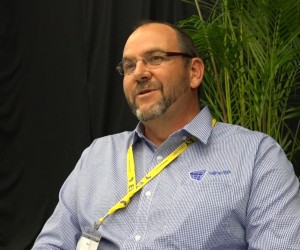One of the critical pillars to any small, medium or large mining house’s success is the level of software integration and the application therein to manage all resources.
A prime example is proudly South African MineRP, the world's leading provider of Enterprise Integration Solutions for the mining technical software industry.
In a nutshell, they allow geologists, mine planners, surveyors, mineral resource managers and other mining technical specialists to collaborate and share their data in a meaningful and consumable way, to other stakeholders inside and outside of the mining organisation.
As we move closer to full mechanisation, so too does the reliance on cutting edge software to save operational costs. It’s almost become like Formula1, a battle of money and technology.
However, if used properly, technology can save you 10% of your total operating costs according to Pieter Nel, CEO at MineRP, who sat down with Gregory Simpson recently.
You’ve a formed a partnership with IBM to develop cutting edge software, specifically designed for mining. Can you elaborate on that?
We believe that to develop a solution for the mine technical systems environment there’s no company that’s big enough in this space that can pull it off. You can only do that with the right partners and we have invested a lot of time and effort through North West (Pukke) University and Wits University to ask who the best people in the analytical optimisation environment in the world are so that we can bring those products to bear in the mining space. And the answer was IBM – so it’s just over a year now that we’ve got this partnership where we focus on consolidation of the mine technical data and then we transfer that data in a format that any optimisation tool or analytical tools that the guys use in the big data environment. This data can then be used to do analysis and optimisation. We’re now busy with two big projects as proof the concept. Dirk Claessens did a presentation at the Mining Indaba where he explained some of the results that we’ve got. For an underground operation on one shaft to get anything between five to 10% improvement on NPV is small.
You can guarantee companies that five to 10% saving, as a minimum?
Just at the first step, yes.
What are the projections going forward?
This is only focusing on the mining side; if you’ve got a full enterprise optimisation you will get real results and we believe that there will be a big change in improvement if you also bring focus on that – so the five to 10% was only focusing on the normal mining stuff, better planning, better spending of your capital, control on the capital side. It’s not optimising your supply chain, your engineering and all the other supporting services. As soon as you get that in you will see a much bigger difference.
And how easy is it for the user to connect the dots to make that saving?
The challenge for optimisation is data and the quality of data, that’s always a challenge. At MineRP we have been working in this space for the last 10 years when we started developing our spatial database, and it’s only after 10 years that technology improved and we have the right tools in that space to collect data from all these applications. The example that I’ve got for quite a big platinum producer in South Africa was about four to five weeks and you can already see some results. From there on it’s just an ongoing improvement.
And in terms of health and safety in making the mine a safer place, this obviously ties in quite closely with that?
Surface mining is much easier, but underground it’s quite a challenge but what’s nice with the consolidation and collaboration of your data from all these different applications is that it brings everything into one area and we’ve got the tools. One of these tools is mine forms using flow centric in that space. The system will send a sms or warnings to different people in the organisation to make them aware that we are nearing a safety pillar or you’re busy mining in the safety pillar.
Energy is another big buzz word. How is this technology going to help in that regard?
That’s why we partnered with IBM. They’ve got world-class energy saving tools on all the optimisation tools. They are working all over the world in this space so what we’re doing is bringing the mining operations closer to that – so that’s something we will do going forward.
Can you compare technology in mining when you first started working to where we are now?
If you take ’81, ‘91 there was one or two computers on the mine, everything was done manually. People spent hours recording some of the things in a visual way on plans – all that is now immediately available. There are still challenges. What mining requires are complex data sets and there was a stage when technology wasn’t ready to support that. We are now with a memory data basis and working very closely with HANA, Health SAP as well as the solutions that we’ve got from IBM. We can now do calculations to immediately bring together all these massive data sets.
How much of the software is designed and developed in South Africa?
We started off with the bulk of our development in South Africa, out of the Anglo-American group. We also worked with a development shop in Brisbane as well as one in Sudbury, Canada. To develop an enterprise solution the left hand must know what the right hand is doing. Our office is now in Centurion where we’ve got 85 technical people doing the development work and I’ll say all the IT belongs in South Africa. We are proudly South African and our focus is on developing solutions for developing countries. Although we’ve got a lot of things in Australia and North America – but we are proudly South African.
And would your numbers be able to tell us where the next growth markets are going to be in Africa?
Well if you just take on the report from PWC and Lloyd’s, exploration is a big focus in Africa. If you take what’s happening in the commodity market it’s possible for us to play in that environment. One of our tools that we develop is GeoGovernment and that’s a tool to manage a continent or a countries natural and mining resource. So it’s possible for us, with the partnership with IBM, to print a balance sheet to see the status of your mineral resources.
Gregory Simpson
PULL QUOTE: “The challenge for optimisation is data and the quality of data, that’s always a challenge”
PULL QUOTE: “That’s why we partnered with IBM. They’ve got world-class energy saving tools on all the optimisation tools.”
BOX: Did you know?
Software patents, like other types of patents, are theoretically supposed to give an inventor an exclusive, time-limited license for a detailed idea (e.g. an algorithm) on how to implement a piece of software, or a component of a piece of software. Ideas for useful things that software could do, and user requirements, are not supposed to be patentable, and concrete implementations (i.e. the actual software packages implementing the patent) are not supposed to be patentable either – the latter are already covered by copyright, generally automatically. So software patents are supposed to cover the middle area, between requirements and concrete implementation. In some countries, a requirement for the claimed invention to have an effect on the physical world may also be part of the requirements for a software patent to be held valid – although since all useful software has effects on the physical world, this requirement may be open to debate.






